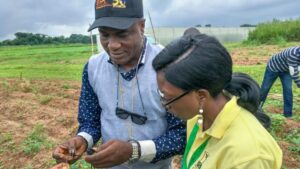Researchers from North Carolina State University found that HPC1, a crucial gene in maize, modulates specific chemical processes that aid in flowering time. The gene comes from “teosinte mexicana,” a predecessor of modern-day corn that lives in the wild highlands of Mexico.
The discoveries offer more information on plant evolution and trait selection that could potentially impact corn and other crops’ adjustment to low temperatures, according to a release from the university.
Corn grown at higher altitudes, such as the highlands of Mexico, require accommodations to grow successfully.
“At high elevations, in colder temperatures, it takes longer to make a maize plant due to lower heat unit accumulation — corn needs to accumulate heat or growth units,” said Rubén Rellán-Álvarez, assistant at NC State. “At 10,000 feet (2,600 meters), it takes three times longer to make a maize plant than at lower elevations.
“To adapt to these special conditions campesinos — smallholder farmers — must plant early in the season and plant deep in the soil; there is very slow but steady growth in earlier months until the rainy season arrives. Over millennia, campesinos have selected maize varieties that can thrive in these special conditions by being able to grow at low temperatures and flower early before the colder months arrive in the winter.”
The HPC1 gene is crucial for these conditions. Corn varieties grown at lower elevations use the gene to break down phospholipids that have shown to cling to proteins that speed-up flowering time.
“Phospholipids are also important building blocks of cell membranes. All lipids have different shapes and balancing these shapes is what allows membranes to stay intact and helps plants to survive periods of stress,” explained Allison Barnes, co-first author of the paper.
In mountainous regions, the gene misfires.
“In highland maize a defective version of the gene was selected and this led to high levels of phospholipids,” said Rellán-Álvarez. “We developed a CRISPR-Cas9 mutant and confirmed the metabolic function of the gene. We also showed similar phospholipid-protein interactions that had been described in other species to regulate flowering time.”
“The phospholipids that are not broken down in the highlands may be better for keeping membranes together, allowing the plant to survive the adverse environment,” added Barnes.
Researchers conducted experiments in lowlands and highlands throughout Mexico with the highland version of the gene. They discovered that maize with the highlands version flowered one day before plants void of the gene. Corn planted in the lowlands that contained the highlands version of the gene flowered a day after the plants without that gene version.
The team also analyzed the evolution of maze over thousands of years of farmer selection across the Western Hemisphere. Native Americans domesticated corn in southwest Mexico from the wild plant teosinte parviglumis. They brought and adapted the crop across the Americas where corn was then crossed with a different wild plant — teosinte Mexicana, according to the release.
“Our results show that the mixture of maize with teosinte mexicana helped maize adapt to highland conditions and that this mixture is relevant in modern corn,” said Rellán-Álvarez.
Researchers learned that genetic pieces from teosinte Mexican— the highlands version of HPC1— are present in modern-day maize.
“This retention — what scientists call introgression — is similar to modern-day humans retaining bits of Neanderthal in their genetic code. These pieces have been retained because they have been selected over time and bring some advantage,” said Rodríguez-Zapata.
The study also revealed the highlands variant of HPC1 in Canada, the northern U.S. and northern Europe. Researchers are now analyzing the role of HPC1 and other genes included in phosphorus metabolism to uncover sustainable ways to grow maize and potentially carry more teosinte Mexicana into today’s corn.
Read More:
A Strong Defense Strategy is Crucial for Corn Growers to Manage Pests
Corn Acres Down in 2022, Soybean Acreage Up
GM Corn Presents No Risk to Non-Target Organisms
Corn Replant Decisions Made Easier with “Corn Replant Calculator”













